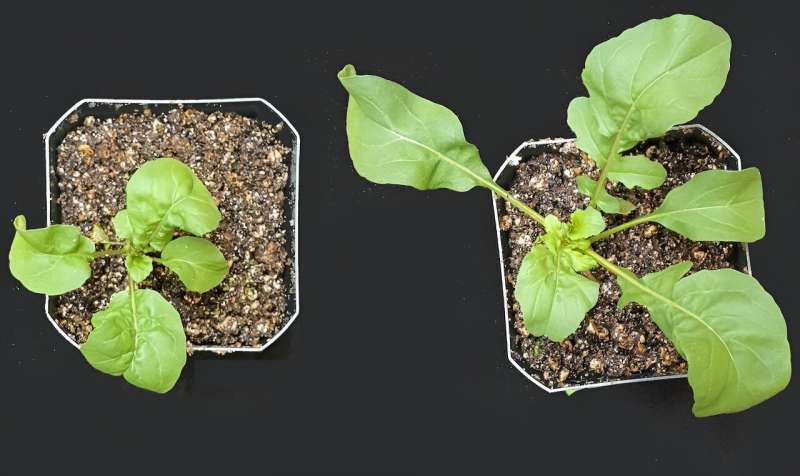Exposing plants to an unusual chemical early on may bolster their growth and help feed the world

Just like any other organism, plants can get stressed. Usually it's conditions like heat and drought that lead to this stress, and when they're stressed, plants might not grow as large or produce as much. This can be a problem for farmers, so many scientists have tried genetically modifying plants to be more resilient.
But plants modified for higher crop yields tend to have because they put more energy into growth than into protection against stresses. Similarly, improving the ability of plants to survive stress often results in plants that produce less because they put more energy into protection than into growth. This conundrum makes it .
how the plant hormone ethylene regulates growth and stress responses in plants. In a , my lab made an unexpected and exciting observation. We found that when seeds are germinating in darkness, as they usually are underground, adding ethylene can increase both their growth and stress tolerance.
Ethylene is a plant hormone
Plants can't move around, so they can't avoid stressful environmental conditions like heat and drought. They take in a variety of signals from their environment such as light and temperature that shape how they grow, develop and deal with stressful conditions. As part of this regulation, plants that are part of a regulatory network that allows them to adapt to environmental conditions.
was first discovered as a gaseous plant hormone . Since then, research has shown that all land plants that have been studied make ethylene. In addition to controlling growth and responding to stress, it is also involved in other processes such as causing leaves to change color in the fall and stimulating fruit ripening.
Ethylene as a way to 'prime' plants
My lab focuses on how plants and bacteria sense ethylene and on how it interacts with other hormone pathways to regulate plant development. While conducting this research, my group made .
We'd been running an experiment where we had seeds germinating in a dark room. Seed germination is a critical period in a plant's life when, under favorable conditions, the seed will transition from being dormant into a seedling.
For this experiment, we'd for several days to see what effect this might have. We'd then removed the ethylene. Normally, this is where the experiment would have ended. But after gathering data on these seedlings, we transferred them to a light cart. This is not something we usually do, but we wanted to grow the plants to adulthood so we could get seeds for future experiments.
Several days after placing the seedlings under light, some lab members made the unexpected and startling observation that the plants briefly gassed with ethylene . They had larger leaves as well as longer and more complex root systems than plants that had not been exposed to ethylene. These plants continued growing at a faster rate throughout their whole lifetime.
My colleagues and I wanted to know if diverse plant species showed growth stimulation when exposed to ethylene during seed germination. We found that . We tested the effects of short-term ethylene treatment on germinating tomato, cucumber, wheat and arugula seeds—all grew bigger.
But what made this observation unusual and exciting is that the brief ethylene treatment also such as salt stress, high temperature and low oxygen conditions.
Long-term effects on growth and stress tolerance from brief exposure to a stimulus are often called priming effects. You can think of this much like , where the priming helps get the pump started easier and sooner. at various ages and stages of development. But with various chemicals and stresses has probably been the most studied because it is easy to carry out, and, if successful, it can be used by farmers.
How does it work?
Since , my lab group has tried to figure out what mechanisms allow for these ethylene-exposed plants to grow larger and tolerate more stress. We've found a few potential explanations.
One is that ethylene priming increases photosynthesis, the process plants use to make sugars from light. Part of photosynthesis includes what is called , where plants take CO2 from the atmosphere and use the CO2 molecules as the building blocks to make the sugars.
My lab group showed that there is a large increase in carbon fixation—which means the plants are taking in much more CO2 from the atmosphere.
Correlating with the increase in photosynthesis is a large increase in carbohydrate levels throughout the plant. This includes large increases , which is the energy storage molecule in plants, and two sugars, and , that provide quick energy for the plants.
More of these molecules in the plant has been linked to both and a better ability for plants to .
shows that environmental conditions during germination can have profound and long-lasting effects on plants that could increase both their size and their stress tolerance at the same time. Understanding the mechanisms for this is more important than ever and could help improve crop production to feed the world's population.
Provided by The Conversation
This article is republished from under a Creative Commons license. Read the .![]()





















